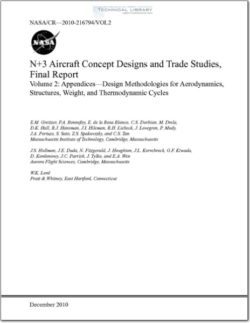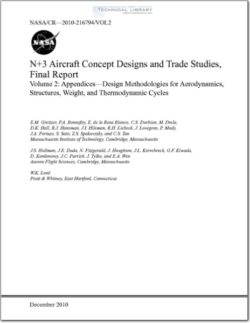NASA-CR-2010-216794 Vol 2

- Version
- 232 Downloads
- 5.01 MB File Size
- 1 File Count
- November 27, 2015 Create Date
- November 27, 2015 Last Updated
Aircraft Concept Designs

A. 1 Introduction
A.1.1 Background
There is a vast body of work on conceptual and preliminary aircraft design. The more
traditional approaches of e.g. Roskam [1], Torrenbeek [2], Raymer [3], have relied heavily on
historical weight correlations, empirical drag build—ups, and established engine performance
data for their design evaluations. The ACSYNT program [4H5] likewise relies on such
models, with a more detailed treatment of the geometry via its PDCYL [6] extension.
More recently, optimization—based approaches such as those of Knapp [7], the WINGOP code
of Wakayama [8],[9], and in particular the PASS program of Kroo [10] perform tradeoffs in
a much more detailed geometry parameter space, but still rely on simple drag and engine
performance models.
The recent advent of turbofan engines with extremely high bypass ratios (Pratt geared tur—
bofan), advanced composite materials (Boeing 787), and possibly less restrictive operational
restrictions (Free—Flight ATC concept), make it of great interest to re—examine the overall
aircraft /engine/operation system to maximize transportation efficiency. NASA’s N+1,2,3
programs are examples of research efforts towards this goal. In addition, greater empha—
sis on limiting noise and emissions demands that such aircraft design examination be done
under possibly stringent environmental constraints. Optimally exploiting these new factors
and constraints on transport aircraft is a major motivation behind TASOPT’s development.
A.1.2 Summary
Overall approach
To examine and evaluate future aircraft with potentially unprecedented airframe, engine,
or operation parameters, it is desirable to dispense with as many of the historically—based
methods as possible, since these cannot be relied on outside of their data—fit ranges. The ap—
proach used by TASOPT is to base most of the weight, aerodynamic, and engine—performance
prediction on low—order models which implement fundamental structural, aerodynamic, and
thermodynamic theory and associated computational methods. Historical correlations will
be used only where absolutely necessary, and in particular only for some of the secondary
structure and for aircraft equipment. Modeling the bulk of the aircraft structure, aerody—
namics, and propulsion by fundamentals gives considerable confidence that the resulting
optimized design is realizable, and not some artifact of inappropriate extrapolated data fits.
Airframe structure and weight
The airframe structural and weight models used by TASOPT treat the primary structure
elements as simple geometric shapes, with appropriate load distributions imposed at critical
loading cases. The fuselage is assumed to be a pressure vessel with one or more “bubbles”,
with added bending loads, with material gauges sized to obtain a specified stress at specified
load situations. The wing is assumed to be cantilevered or to have a single support strut,
whose material gauges are also sized to obtain a specified stress. The resulting fuselage, wing,
and tail material volumes, together with specified material density, then gives the primary
structural weight. Only the secondary structural weights and non—structural and equipment
weights are estimated via historical weight fractions.
| File | Action |
|---|---|
| NASA-CR-2010-216794-Vol-2-Aircraft-Concept-Designs.pdf | Download |
Comment On This Post